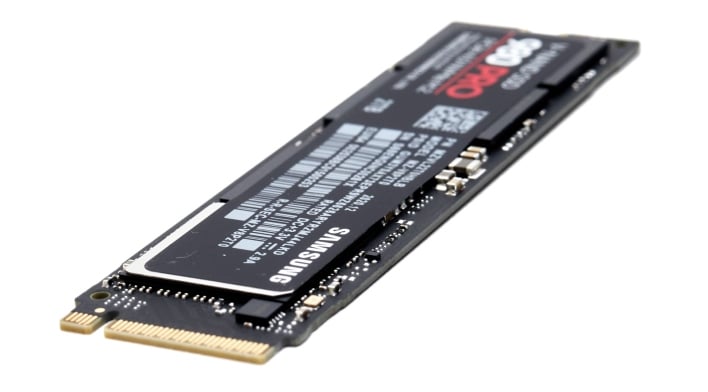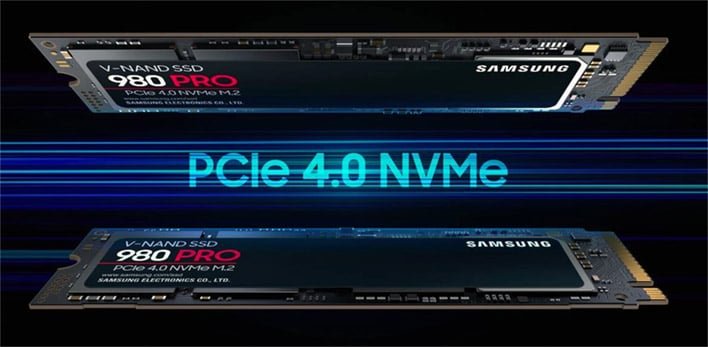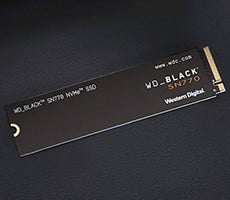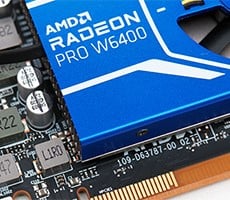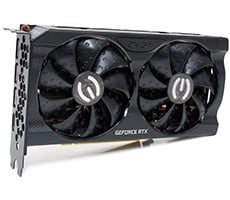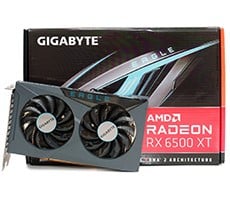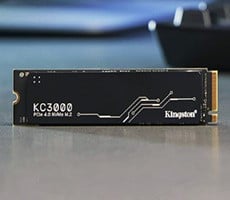Samsung SSD 980 Pro 2TB Review: Flagship PCIe 4 NVMe Storage
Except for its obviously higher capacity, the 2TB Samsung SSD 980 Pro doesn’t differ from the smaller drives that were previously made available. Due to how the drives function, however, the higher capacity does alter the performance profile a bit. We’ll explain exactly how and why that happens when we get to the benchmarks. For now, here’s a quick breakdown of the drive’s main features and specifications. Take a gander and we’ll dig in deeper down below...
|
| Capacity | 2000GB |
| Form Factor | M.2 2280 |
| Interface / Protocol | PCIe 4.0 x4 / NVMe 1.3c |
| Controller | Samsung Elpis |
| DRAM | 2GB LPDDR4 |
| NAND Flash | Samsung TLC |
| Sequential Read | 7,000 MB/s |
| Sequential Write | 5,100 MB/s |
| Random Read | 1,000,000 IOPS |
| Random Write | 1,000,000 IOPS |
| Endurance (TBW) | 1200 TBW |
| Warranty | 5-Years |
With the launch of the 2TB model, Samsung SSD 980 Pro Gen 4 drives are now offered in four capacities -- 250GB, 512GB, 1TB and 2TB. Our article featuring the 250GB and 1TB models was posted when the drives were initially made available, so if you’d like to see how the lowest capacity drive performs, check out that article -- we’ve got the 1TB drive listed in our benchmarks for easy comparisons, though.
All of the drives in the Samsung SSD 980 Pro series use the common M.2 (2280) ‘gumstick’ form factor, but the performance between the different models varies based on their capacity. The 250GB drive is rated for peak read bandwidth of 6.4GB/s, with 2.7GB/s writes, for examples, but the larger 2TB drive featured here offers higher speeds that top out at up to 7GB/s reads with up to 5.1GB/s writes.
The Samsung SSD 980 Pro drives’ max IOPS ratings also vary depending on queue depth, but peak at right around 500K – 1,000K at QD32 depending on the capacity. The drives’ endurance ratings vary based on capacity too, as you would expect, with the 250GB drive landing at the 150TBW mark and the big 2TB drive hitting 1200TBW. That’s half of what the previous-gen 970 Pros are rated for, but should still be plenty for the vast majority of consumer use cases.
The Samsung SSD 980 Pro series features Samsung’s latest V-NAND flash memory. To be specific, the drives are equipped with 6th generation, 1xx-layer (up to 136 layer) TLC V-NAND flash with 3D charge trap flash (CTF) cells. This 6th generation V-NAND offers up to 10% lower latency for reads and writes, at up to 15% lower power than previous-generation V-NAND.
The drives are also outfitted with a new controller, dubbed Elpis. In addition to the aforementioned native PCI Express 4.0 interface, the Elpis controller supports 4x the number of maximum queues as the Phoenix controller used on the 970 series (32 vs. 128). And the Elpis controller is manufactured on a leading-edge 8nm process as well.
The Elpis controller supports all of the features you’d expect from a modern SSD, like TRIM, garbage collection, S.M.A.R.T., etc., in addition to various encryption technologies. Depending on the capacity, all of the drives also feature 512MB to 2GB of discrete LPDDR4 DRAM cache. The 2TB drive here packs the maximum 2GB of DRAM.
The Elpis controller has a nickel coating that helps to dissipate heat and the underside of the drives has a thin copper plate hidden underneath the decal to aid in cooling as well – you can see the copper if you look closely around the edges of the decal.
In somewhat of a twist, Samsung SSD 980 Pro drives feature TurboWrite technology, similar to Samsung EVO-branded drives. TurboWrite uses a portion of the drives’ V-NAND as an SLC write buffer, which results in improved write performance, as long as the buffer isn’t exhausted. With 980 Pro drives, Samsung has tweaked the algorithm and TurboWrite capacities versus older drives, so it’s virtually transparent to end users, at least on the higher capacity drives.
As was the case with previous-gen drives, the TurboWrite buffer dynamically adjusts in size based on the workload. With the 250GB model, the TurboWrite buffer can be as large as 45GB if the drive has enough unused capacity, which is much larger than the 970 EVO series. The 1TB drive’s TurboWrite buffer can scale as large 108GB and the 2TB drive featured here maxes out at 216GB. The larger TurboWrite buffers in the 980 Pro series give them the ability to maintain maximum write performance up to 92% longer than the 970 EVO Plus series.
TurboWrite will allow the Samsung SSD 980 Pro drives to perform well in the vast majority of consumer-class workloads, because writes are fastest when the SLC buffer is being utilized. Once the buffer is exhausted, write performance either tapers off or becomes somewhat more erratic on the lower-capacity drives (512GB and below), but on the 1TB and 2TB drives, the SLC cache is flushed fast enough to maintain strong write performance across the entire capacity of the drive.
Samsung warranties the SSD 980 Pro series drives for 5 years, which is in-line with previous-gen offerings. Anecdotally, in all of the years we have been evaluating Samsung SSDs, we have yet to have one fail. Every one of the Samsung drives we have on hand, including much older SATA-based solutions, are still functioning properly.
Samsung SSD 980 Pro 2TB Benchmarks
Under each test condition, the SSDs tested here were installed as secondary volumes in our testbed, with a separate drive used for the OS and benchmark installations. Our testbed's motherboard was updated with the latest BIOS available at the time of publication. The SSDs were secure erased prior to testing (when applicable), and left blank without partitions for some tests, while others required them to be partitioned and formatted, as is the case with the ATTO, PCMark, and CrystalDiskMark tests. Windows firewall, automatic updates, and screen savers were all disabled before testing and Windows 10 Quiet Hours / Focus Assist was enabled.
In all test runs, we rebooted the system, ensured all temp and prefetch data was purged, waited several minutes for drive activity to settle and for the system to reach an idle state before invoking a test. Also note, we have completely revamped our test bed, so the numbers shown in this review aren’t comparable to previous articles. All of the drives here have also been updated to their latest firmware and where applicable.
|
| Processor - Motherboard - Video Card - Memory - Audio - Storage - |
AMD Threadripper 3990X MSI TRX40 Creator (TRX40 Chipset) GeForce RTX 2080 Ti 32GB G.SKILL DDR4-3200 Integrated on board Corsair MP600 (OS Drive) Samsung SSD 980 Pro (2TB) Samsung SSD 980 Pro (1TB) Gigabyte Aorus NVMe PCIe 4 (2TB) Samsung SSD 970 Pro (512GB) ADATA XPG GAMMIX S70 (2TB) |
OS - Chipset Drivers - DirectX - Benchmarks - |
Windows 10 Pro x64 (2004) AMD v2.07.14.327 DirectX 12 IOMeter HD Tune v5.75 ATTO v4.01.0f AS SSD CrystalDiskMark v7 x64 PCMark 10 Quick Storage Bench SiSoftware SANDRA |
|
In the following tables, we're showing two sets of access patterns; a custom Workstation pattern, with an 8K transfer size, consisting of 80% reads (20% writes) and 80% random (20% sequential) access and a 4K access pattern with a 4K transfer size, comprised of 67% reads (33% writes) and 100% random access. Queue depths from 1 to 32 were tested...
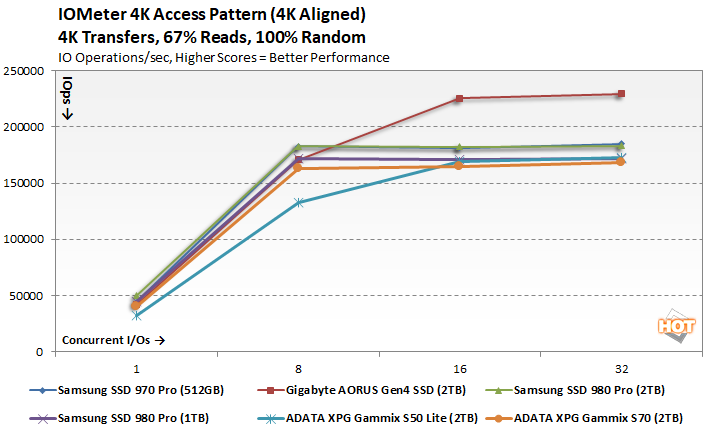
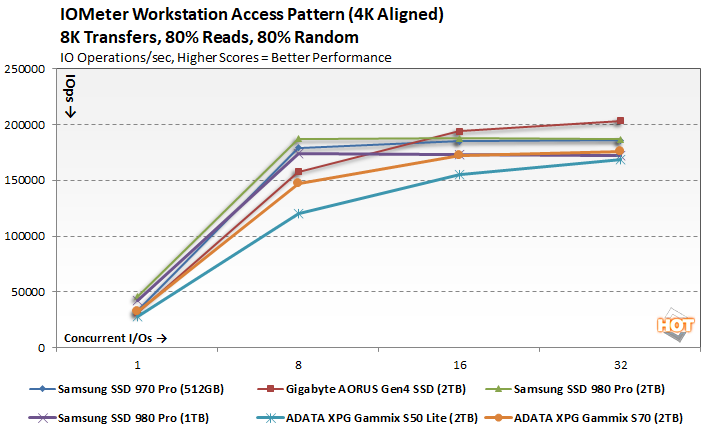
For the most part, the new 2TB Samsung SSD 980 Pro performed right on par with its lower-capacity 1TB counterpart, though it did pull ahead slightly at the lower queue depths.
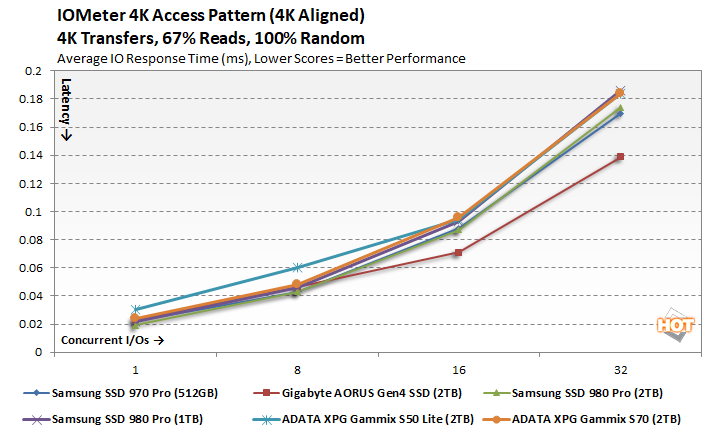
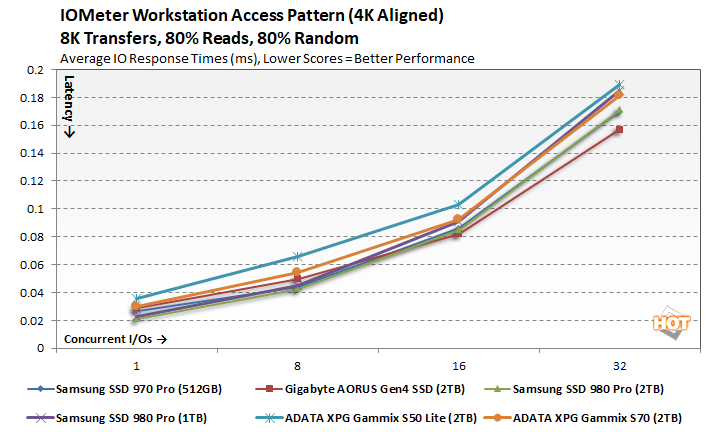
|
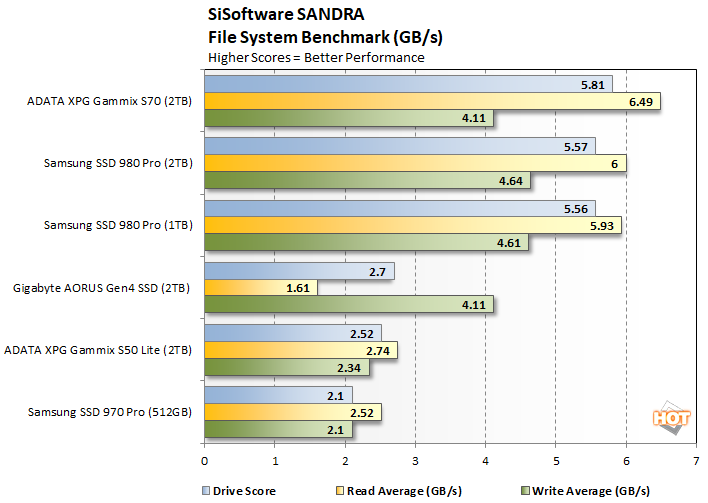
The 2TB Samsung SSD 980 Pro once again performs right on par with the 1TB model. And although it lands in the second place position overall, note it actually had the best write performance in this benchmark. The ADATA drive takes the pole position due to its stronger read score.
|
ATTO is another "quick and dirty" type of disk benchmark that measures transfer speeds across a specific volume length. It measures raw transfer rates for both reads and writes and graphs them out in an easily interpreted chart. We chose .5KB through 64MB transfer sizes and a queue depth of 6 over a total max volume length of 256MB. ATTO's workloads are sequential in nature and measure raw bandwidth, rather than I/O response time, access latency, etc.
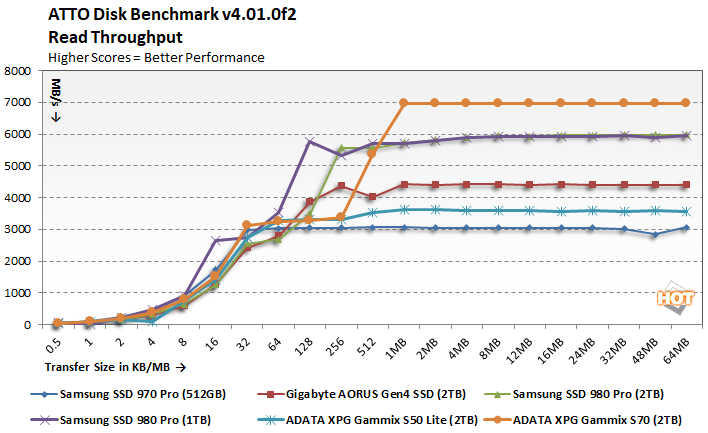
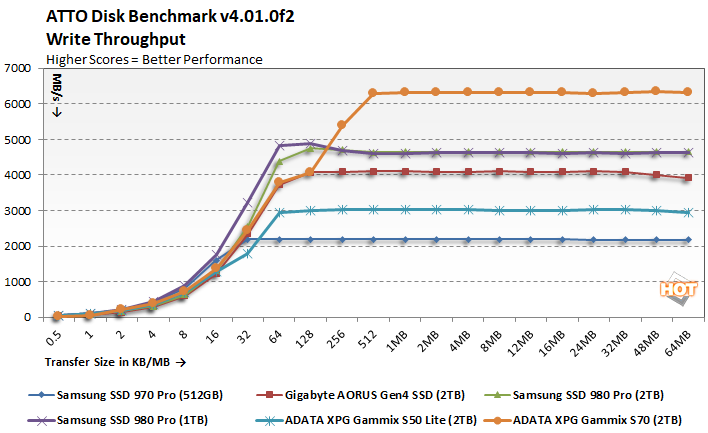
In ATTO's read and write bandwidth tests, Samsung 1TB SSD 980 Pro drives offers slightly better read and write performance at transfer sizes below the 64K - 128K range, but things level off and the two drives perform similarly with larger transfers. Overall, the SSD 980 Pro's performance is strong, but the ADATA S70 with its InnoGrit controller and Micron NAND takes the lead in sequentials.
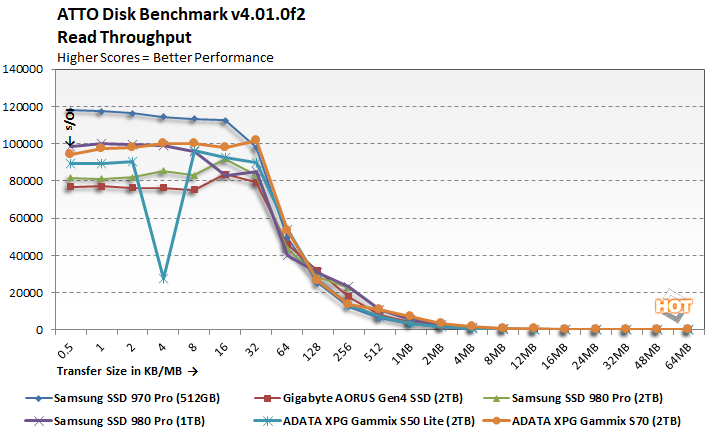
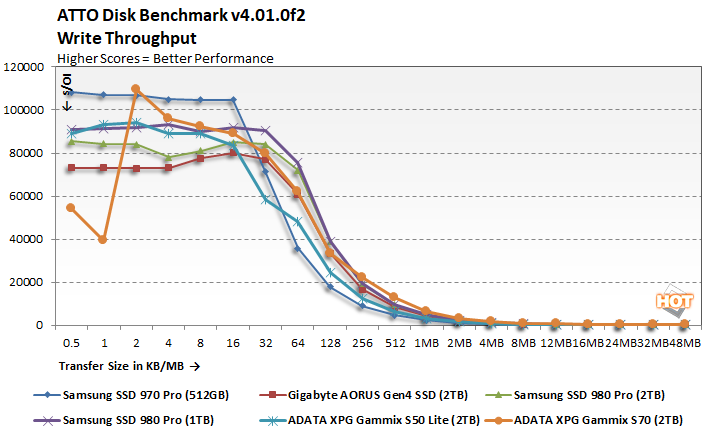
The 2TB Samsung SSD 980 Pro's IOPS also trail the 1TB model at the smaller transfer sizes, and land about in the middle of the pack. Once again though, performance between the 1TB and 2TB model equalizes with larger transfers.
|
Next up we ran the Compression Benchmark built-into AS SSD, an SSD specific benchmark being developed by Alex Intelligent Software. This test is interesting because it uses a mix of compressible and non-compressible data and outputs both Read and Write throughput of the drive. We only graphed a small fraction of the data (1% compressible, 50% compressible, and 100% compressible), but the trend is representative of the benchmark’s complete results.





